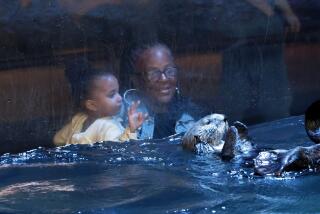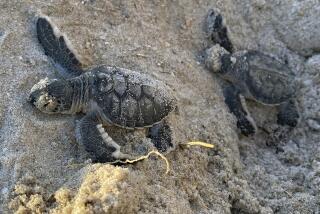Helping turtles get back in the swim
MARATHON, FLA. â The turtles at this waterfront hospital have been hit by boat propellers, caught in fishing nets, attacked by sharks, stricken with tumors and lost flippers.
Or, as their veterinarian puts it, theyâve had a heck of a lot of luck.
Most injured turtles are never spotted and die at sea. The fortunate ones are brought to the Turtle Hospital -- a converted strip club where workers graft the waterproof fabric Gore-Tex to patch badly injured shells and find other innovative ways to save lives.
On this particular day, a 13-pound green sea turtle named Fin is being treated for a potentially debilitating tumor.
âHeâs got a new life now,â says Dr. Doug Mader, the centerâs chief veterinarian.
The sea-foam green hospital, halfway through the Florida Keys, offers round-the-clock care to the turtles that call the waters around this ribbon of islands home.
Morning is just beginning, and the hospitalâs patients are already being prepped on the X-ray room floor. Iain, an 89-pound loggerhead, and Fin are on their backs in plastic kiddie pools, being sprayed with disinfectant. Another green sea turtle on deck for surgery, 37-pound Rocky Thyme, awaits attention.
Iain is eventually lifted onto a steel cart and wheeled into the operating room. A half-dozen hospital staffers gather around the turtle, including Mader, who is wearing blue Wrangler jeans and Teva sandals.
âReady?â Mader asks.
âReady,â says Richie Moretti, the hospitalâs founder and director, who assists in surgery but is not a veterinarian. And a morning of surgery begins.
Iainâs tumor is removed with the flash of a laser. Finâs surgery is a bit more complex: Her flippers flutter against a white towel as a breathing tube is inserted, and a manual respirator causes her shell to lift slightly with her lungs every six to seven seconds as 15 tumors are removed.
Finally the surgeons move on to Rocky Thyme, who has clung to life even though a boat split her spine.
Rocky has external tumors and is weakened by injury. If she has internal tumors too, she will have to be euthanized.
Mader enters Rockyâs body with an endoscope; a crack in her shell glows orange from the light. On a small Sony screen, the black-and-white image shows her insides -- lungs, kidneys, intestines.
âGood news,â Mader says. Rocky shows no signs of internal tumors. Sheâll be nursed back to health and eventually have external tumors removed to prevent the fibropapilloma from spreading.
There is a bittersweet side to this: Rocky is still paralyzed and will never fully recover. She can never again live in the wild.
Moretti bought a 21-room motel next door to the strip club in 1981. He turned a saltwater pool into an aquarium for fish, but children fascinated by the cartoon âTeenage Mutant Ninja Turtlesâ kept asking where the turtles were.
The only way the state would let him keep endangered animals was to help rehabilitate them. So in 1986, the hospital was born.
At first, it was a makeshift operation. Turtles were mostly sent to local veterinarians for treatment and nursed back to health at the motel. But surgeries were done there too, and guests could see vets in scrubs carrying turtles into motel rooms for treatment.
In 1991, Moretti bought the shuttered strip club. The motel had to close after Hurricane Wilma in 2005, but the turtle sanctuary has lived on.
Out back, a 100,000-gallon pool -- and a number of smaller ones -- houses recuperating turtles. Some can only float, with spinal cord injuries causing paralysis. Some have the bite marks of a shark on their shells. One was attacked by wild dogs.
Along the way, Mader, 51, and others have had little guidance on how to treat the creatures. Other turtle hospitals exist, though treatments can still be tricky -- a drug thatâs effective on humans or even dogs and cats probably has never been tested on sea turtles.
Even 12 years later, Mader winces as he remembers using canine pain medication on two turtles. One died. The other nearly did.
âYou feel so bad,â he said.
Despite the illness and injuries, this is a place of happiness.
Hale, a 68-pound green sea turtle who spent a year hospitalized, is being released. He came here entangled in fishing line wrapped so tight it cut down to the bone. His right front flipper was amputated and tumors plagued him. Now he is ready to leave.
The turtle flops around in seeming anticipation once heâs loaded into a black plastic container. After a short trip to the dock, Hale is taken 12 miles out to sea on Morettiâs boat.
Moretti and Ryan Butts, the hospitalâs administrator, lift the container to the boatâs ledge. Hale lowers his head and, in a moment, he disappears.
Everyone on board raises a bottle of water, and Moretti offers a toast.
âTo the turtles,â he says.
Back at the hospital, the three patients who underwent surgery are resting in their pools, shrouded in wet towels.
Theyâll spend the night recovering. Fin and Iain may one day return to sea -- the moment staff members relish, the one they talk about for years.
Mader remembers the first time they grafted a shell. It took months for Puka to heal, and finally the day came, as it has for more than 1,000 turtles theyâve released. When she first hit the water, it was joyous.
âIf a turtle could smile,â he said, âshe was smiling.â
Everyone has his own perception of what makes these animals so captivating -- their peacefulness, their personalities, the affection in their eyes and face.
For Mader and Moretti, it is the sense of history, being near an animal that has lived since prehistoric times and struggles to survive today. To them, each turtle matters. Each turtle is a gift. And with each turtle saved, the species stands a better chance of survival.
More to Read
Sign up for Essential California
The most important California stories and recommendations in your inbox every morning.
You may occasionally receive promotional content from the Los Angeles Times.










